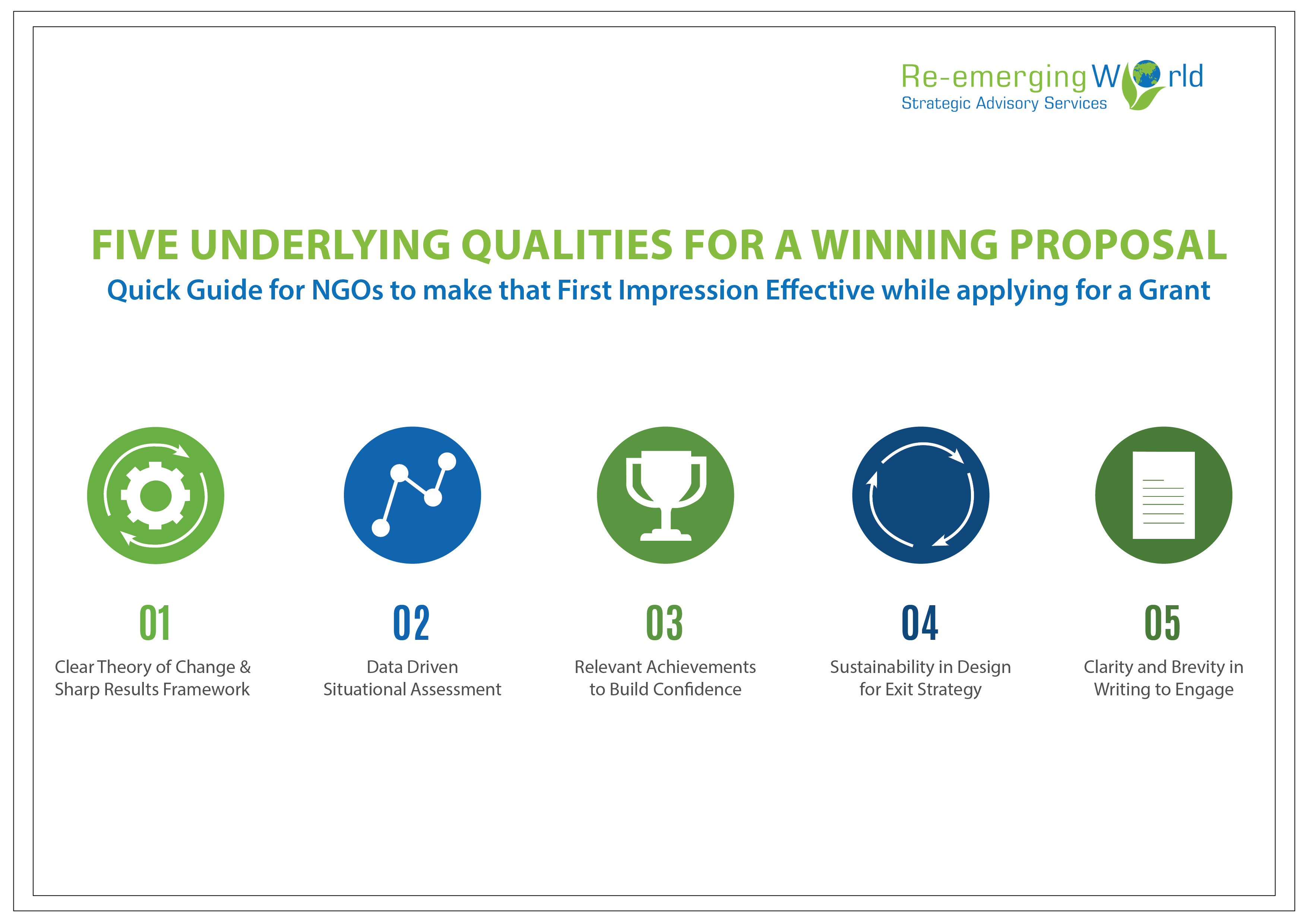Five Underlying Qualities for a Winning Proposal: Quick Guide for NGOs to make that First Impression Effective while Applying for a Grant

Most donor organizations have their own standard templates for inviting grant applications, which provide the applicants a chance to share their proposed project in a structured way. For the donors, these are great tools to assess the projects and make a first level of shortlist. A compelling write up at this stage creates an effective first impression and shoots up the chances of getting selected for the next rounds of assessment.
Let us see the five underlying qualities in a winning proposal, mastering which you can navigate through most grant application templates.
1. Compose a Clear Theory of Change which can be Translated into a Sharp Results Framework
A Theory of Change (TOC) maps the causal chain of activities, outputs, outcomes, intermediate impacts and long-term goals and helps to trace back the necessary pre-conditions to achieve what the project intends to do. If you have a well etched out TOC before starting to write the proposal, it will guide you in writing the proposal sections on Strategy, Key Project Activities, and Intended Impacts. However, donors often request the applicants to quantify these. Always use SMART (Specific, Measurable, Achievable, Relevant and Time-bound) Indicators to construct the Activity, Output and Outcome Indicators in your Results Framework. So instead of saying, “The program aims to convert a significant area of land under bio-farming,” it is better to say, “The program aims to convert 1000 acres of land under bio farming in 3 years”.
2. Build Relevance of your project through a data-driven situational assessment
Why does your target beneficiary group need the project? Donors need to know the project relevance before they even get into how it will be operationalized. That way, donors ensure they are putting their resources into the right problems. The most effective way is to define the problem by using credible data to analyse trends. For example, if your project is about solving food security and nutrition problems in a specified geography – analyse and conclude that XX% of children born in the region in the last 10 years are stunted and YY% of adolescent girls are anaemic. Also, add the “why” part of it – for instance, 90% of the population depends on farm-grown food however the region receives 35% lesser rainfall than average making an uncertain agro-climate. I recommend the data should be sourced from either Government publications or a public report from credible organizations.
3. Showcase Relevant Achievements for Building Confidence
Your project may fall under two categories – an existing project which needs scale up or deepening support or a new project which you want to pilot and need donor support. In either situation, showcase your achievements in the proposal to build the confidence of the donor organization. For an existing project, highlight the key impacts, outreach, and scale you have achieved till now, and for a new project showcase the organization’s achievements in the sectors relevant to the proposal.
4. Devise a seamless exit strategy by embedding sustainability in project design
Donors want to support a project which can leave a lasting impact. So, how do you demonstrate that in the proposal? Grant applications provide ample scope to talk about your project design, approach, and operating model – leverage these opportunities to blend in sustainability and demonstrate how the project can continue to be impactful even after the end of the project period. Identify how you can empower the beneficiaries, build social capital and ensure resource linkages that will support sustenance post-withdrawal.
5. Engage the reader through clarity and brevity in writing
Good writing skills come handy while drafting a proposal. Most grant applications have a word and character limits for writing each section pushing the applicants to bring more clarity and precision.
I recommend three ways to better engage the reader.
a. Creative and analytical writing can go hand in hand. Try to paint a picture with words when you talk about the situation and your solution but blend it with data and insights for clarity.
b. Can you talk about your solution in 100 words? Precision is the key, consider the proposal an elevator pitch and screen out less important ideas / insights.
c. Edit at least three times and each time with a different objective. The first edit should focus more on if the right insights and ideas have been captured and less on word limits, the second edit should prioritize precision and curtail sections to a prescribed word or character limits, and finally, the third edit should look at wordsmithing, grammar and final proofreading.










